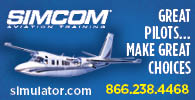Airline pilots know visual approaches as an IFR procedure conducted under IFR in visual conditions, clear of clouds to the airport and flown on a path of their choice. But as a general aviation pilot I first encountered VFR approaches in the Sierra Flight Systems EFIS units (later Chelton Flight Systems) circa 2001.
On the Chelton, when you display your flight plan list you can put the cursor on a waypoint then push a knob to get selections that include VFR APPR if the waypoint is an airport. In Figure 1 (left) we’re proceeding to the Grand Junction VOR and then the airport (KGJT). After making the VFR choice you select the runway (Rwy 11). Then the leg from JNC to KGJT disappears and a flight leg from an initial point (IP) to the airport aligned with Rwy 11 appears (Fig 1, right). The IP is in fact a point leg (IP leg), or waypoint, so you could go Direct to it.

Figure 1. On a flight plan to the Grand Junction airport (left), you can add a VFR approach to Rwy 11 (right) in the Chelton EFIS. That flight leg has a slope and can be tracked by an appropriate autopilot.
You can now do essentially the same thing with a Garmin GTN 650/750 or the G1000 NXi. The Garmin units create a 3-degree glideslope (the VASI makes a 4-degree slope), shown on the Visual Descent Indicator bar and glideslope signals can be coupled to an autopilot. These are GPS slopes (defined by a GPS 3-D position at all points) as opposed to a VNAV course defined by barometric altitude and computer-generated slope. Any autopilot that can fly GPS vertical courses can track these slopes.
There are two ways to add a visual approach into a GTN 650/750. The first is to treat it like any other approach; go to the procedure page, select an approach, then select the visual (there is one for each runway end). In Figure 2 on a flight from Lincoln, California, to Sacramento Executive (KLHM to KSAC) we did just that. Scrolling down the list of approaches at KSAC the visuals are at the end (Figure 2, left). After choosing VISUAL 20 you see the Load or Activate page in Figure 2 (right). Here we loaded it so our course continues to KSAC, and you see a white flight leg representing the visual straight-in to KSAC as shown in Figure 3 (left).

Figure 2. Adding a visual approach in the normal way, using the procedure page to choose one (left) then choosing load or activate (right).

Figure 3. After loading the Visual to Runway 20 into the flight plan, the two flight legs are shown in white (left). The CF leg (a vector) ends at V3NM and the TF leg ends at RW20, the runway threshold. The flight plan list with these two legs is shown on the right.
The modified flight plan is shown in Figure 3 (right) showing a waypoint along this vector at three miles. The approach has two flight legs, the CF leg (course to fix) ending at V3NM and the TF leg (track to fix) ending at RW20, a waypoint at the threshold, not at KSAC, a waypoint in the middle of the airport. Since V3NM is a waypoint, you could go Direct To V3NM, but that’s like intercepting a final approach course inside the final approach fix, which is generally five miles from the airport. The best procedure is to simply intercept the vector at five or six miles at an altitude below the glidepath at the intercept. First, activate the approach, then select a heading to intercept it at a location of your choice. When you turn on course select APR on the autopilot to arm the glideslope.
The second way to add the approach is to wait until you are 10 miles from the destination airport, at which time a “Visual” tile is shown on the lower left corner of the map (hiding that data field). If you touch that it will bring you to the page shown in Figure 2 (left) except that instead of saying Select Approach – KSAC, it says Activate Visual Approach – KSAC. If using this method bear in mind the closeness to the airport and choose altitudes accordingly to fly a coupled approach. However, if you simply want a magenta line to the airport that you will hand fly, then you’ll just make your normal approach but will have the line to show you the extension of the runway centerline.

Figure 4. On reaching a point 10 miles from the airport, the Visual tile appears on the lower left corner of the map, and touching it allows you to activate any visual approach on the list. If you go Direct To V3NM as on the right, you are effectively intercepting the approach inside what would be a normal final approach fix, so better to intercept the vector (after activating the approach).
As with all of these visual approaches, they are not IFR approaches and must be done in visual conditions. Terrain clearance is not guaranteed. But to integrate them into your planned arrival you need to understand these features. Clearly, these are “straight-in” arrivals and with traffic in the pattern you may need to break off this approach and enter the pattern in a normal manner.
Dr. Thomassen has a PhD from Stanford and had a career in teaching (MIT, Stanford, UC Berkeley) and research in fusion energy (National Labs at Los Alamos and Livermore). He has been flying for 63 years, has the Wright Brothers Master Pilot Award, and is a current CFII. See his website (www.avionicswest.com) on all his manuals plus numerous articles on GPS and aviation topics.




